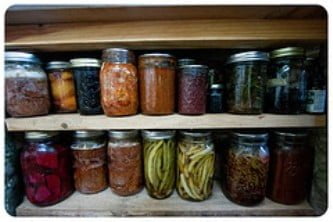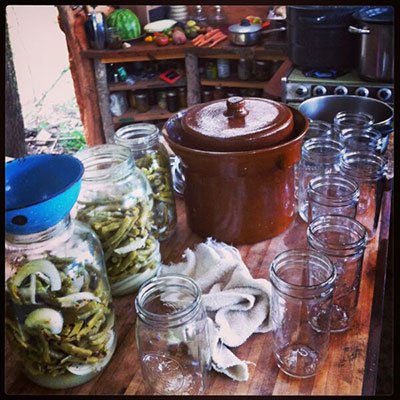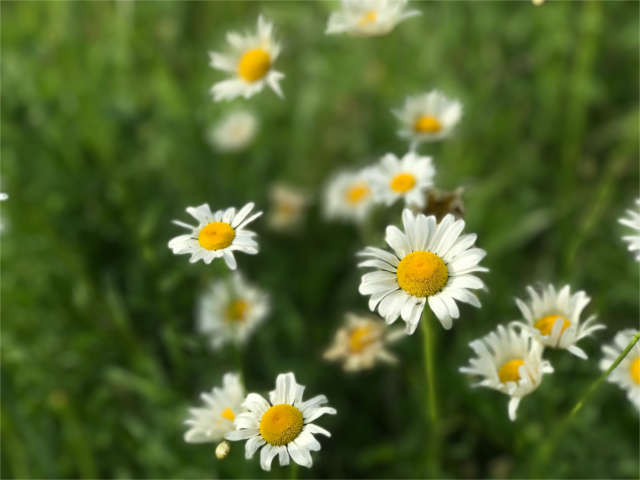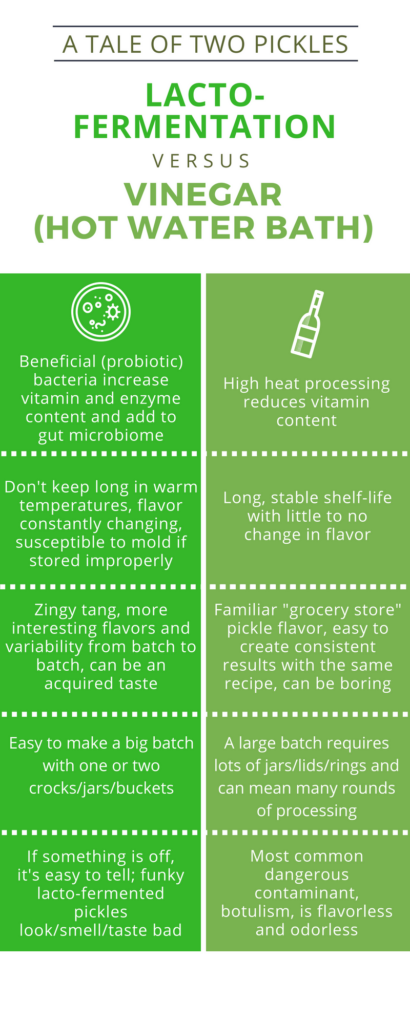Aren’t pickles fun? They’re such a great way to preserve the harvest, plus making pickles gives you a chance to experiment with flavor combinations. Not to mention, pickles of all kinds make great snacks and accompaniments to meals.
Here we explore two very different ways to turn vegetables into pickles: lacto-fermentation and vinegar pickling (with a hot-water bath to preserve them). We don’t stop with vegetables though, read on to discover some of the unconventional morsels we like to throw in the pickle jar. There are lots of other ways to preserve the harvest, too, including root-cellaring and other non-electric methods.
Learn how to lacto-ferment in our in-person healthy cooking classes.
What is pickling?
According to the Merriam-Webster dictionary, a pickle is “an article of food that has been preserved in brine or in vinegar; specifically : a cucumber that has been so preserved.” The origin of the word pickle is a little murky. In fact, it’s been postulated that it may be the last name of medieval Dutch fisherman who came up with the process. But pickling has been around much longer than that. According to an article from PBS, people were pickling cucumbers in the Tigris Valley in 2030 BC! Wherever there are seasons of bounty and of lean times, human beings have made pickles to help get them through.
Pickling is essentially a form of food preservation that works by creating an environment where spoilage organisms can’t thrive—either because of the acidity of vinegar or the salt content of a brine. That’s what makes it such an effective and versatile method, whether you’re preparing a few jars for the fridge or stocking a root cellar.
What gets pickled?
Vegetables are by no means the only foods that get the pickle treatment. However, cucumber pickles and sauerkraut (lacto-fermented cabbage) may be the most popular. Both limes and green mangos are very common fruit pickles in India. Meat can be pickled too. For example, corned beef, pickled pig’s feet, and herring in wine sauce are examples of this. Even whole, hard-boiled eggs can find themselves floating in brine. Feta is a common kind of cheese that gets pickled in its own tangy whey, plus generous salt.
A few of our favorite unconventional pickle ingredients
- oxeye daisy buds and flowers
- Milkweed pods
- Garlic scapes
- Hemlock tips
- Daylily buds
- Basswood leaves
- Wild mushrooms
Lacto-fermentation vs. vinegar pickling
Using vinegar or salty brine are two of the most common ways to pickle.
In the case of salty brine, beneficial bacteria eat the sugars in the vegetables on their way to becoming pickles. As a result, lactic acid is released, turning the saltwater into an acidic solution; this process is called lacto-fermentation. For vinegar pickles, salt is almost always added too. So, what’s the difference between these two sour-salty solutions?
The presence of probiotics, or beneficial bacteria, is the main difference between lacto-fermentation and vinegar pickling. Lacto-fermented pickles are cultured, and full of priobiotics. Additionally, sealing vinegar pickles in a hot water bath is very common. When we do this, we cook both the pickles and the brine. As a result, we can store them at room temperature in their sealed jars for a long time without spoiling. Lacto-fermented pickles are not cooked, and can only be stored for long periods of time at low temperatures (like in a refrigerator or root cellar). Check out our infographic below for a comparison of some of the pros and cons of these two ways to pickle.
Some folks ask: does vinegar prevent fermentation? It does—by lowering the pH so much that bacteria (even good ones) can’t survive. That’s why vinegar pickles don’t contain probiotics unless they’ve been added afterward, which is rare.
Great pickle recipes
Pickle diversity is as vast as human culture. Here are two basic recipes to get started, from two awesome books on food preservation. There are tons of other pickling books out there. We especially encourage you to explore recipes for pickles and preserves from India, Ukraine, Germany and Japan. Those are among the pickle loving cultures who have perfected many piquant delicacies.
Sour Beets (lacto-fermented)
From “Wild Fermentation”
Timeframe: 1 to 4 weeks
Ingredients (for 1/2 gallon):
- 5 pounds beets
- 3 Tablespoons salt
- 1 Tablespoon caraway seeds
Process:
- Grate the beets, coarsely or finely based on your preference
- Sprinkle the grated beets with salt as you go
- Add the caraway seeds and stir to incorporate
- Place the juicy, salt, caraway-y beets into a crock, food-grade plastic bucket, or large glass jar, pack in tightly to squeeze juice from the beets and press out any air bubbles
- Place a weight atop the beets and make sure all of them are submerged
- Cover with a cloth to exclude bugs
- Check after a few days, it will get more sour over time and be “done” in 1-4 weeks depending on temperatures
- When you deem it done, pack into clean jars and store in the refrigerator.
“Dilly” Green Beans (vinegar pickles)
From “Putting Food By”
Ingredients (for 7 pint jars):
- 4 pounds whole green beans
- 1 1/2 crushed, dried red pepper
- 7 fresh dill heads or 3 1/2 teaspoons dried dill seed
- 7 cloves of fresh garlic, peeled
- 5 cups vinegar
- 5 cups water
- 1 cup minus 1 Tablespoon salt (“pickling,” Kosher, or sea salt, not iodized table salt)
Process:
- Sanitize your jars by steaming, boiling, or in a dishwasher
- Fill clean, still-warm jars to the shoulder with clean, trimmed green beans
- In each jar, place 1 dill head or 1/2 tsp dill seed, 1 garlic clove, and 1/4 tsp crushed pepper
- Heat together the water, salt and vinegar to a boil
- Pour brine over the beans, filling each jar 1/2 inch from the top
- Process in a hot water bath canner for 10 minutes after water returns to a simmer
- Remove and let cool, then double-check seals
Are Pickled and Fermented the Same Thing?
While pickling and fermenting are often confused, they’re not exactly the same. Pickling is a general method of preserving food in an acidic solution—usually vinegar or brine. Fermentation, on the other hand, is a biological process in which natural bacteria feed on sugars and produce acids that preserve the food.
So, all fermented foods are pickled (they become acidic), but not all pickles are fermented. Vinegar-pickled items skip the fermentation process and are preserved directly in acid, while lacto-fermented foods rely on beneficial bacteria to create that acidity over time.
How to Tell if Pickles Are Fermented
You can usually tell if pickles are fermented by a few signs:
- Cloudy brine: Lacto-fermented pickles often have cloudy liquid due to microbial activity.
- Fizzing or bubbling: You may see bubbles when you open the jar.
- Sour smell: Fermented pickles have a more complex, tangy smell than vinegar pickles.
- Labeling: If it’s store-bought and doesn’t say “raw,” “unpasteurized,” or “fermented,” it’s probably vinegar-based.
Fermented pickles also tend to be stored in the refrigerator, unless they’re canned in a way that stops fermentation.
Can You Ferment with Vinegar?
Short answer: no. Vinegar is too acidic for the beneficial microbes needed in lacto-fermentation to survive. In fact, one of the reasons vinegar is used in pickling is precisely because it halts microbial activity—bad and good alike.
Lactic acid (created during fermentation) develops over time through bacterial action. Vinegar introduces acidity immediately, making it great for shelf-stable preservation, but not for cultivating probiotics. So, if you’re aiming for those live cultures, stick with saltwater brine.
How to Stop the Fermentation Process
To stop fermentation, you need to drastically slow or halt the bacterial activity. Here are some ways to do that:
- Refrigeration: Cooling slows fermentation almost to a halt.
- Move to cold storage: A root cellar or cold pantry can be a good in-between.
- Canning (for vinegar pickles): Boiling and sealing kill microbes and prevent further fermentation.
Once fermentation is stopped, the pickles will stay at their current level of sourness—so make sure to catch them at the stage you like.
Are Pickled Beets Fermented? What About Sauerkraut?
Pickled beets can be either fermented or vinegar-pickled—it depends on the recipe. Traditional recipes like the one from Wild Fermentation are lacto-fermented, while quick pickled beets usually use vinegar.
Sauerkraut, on the other hand, is a classic fermented food. It’s made with only cabbage and salt, and the fermentation process creates its signature tang. If you’re buying sauerkraut at the store and want the probiotic benefits, make sure it’s labeled raw or unpasteurized.
Frequently Asked Questions About Pickling vs Fermentation
Lacto fermentation is a natural preservation process that uses beneficial bacteria to break down sugars in food, producing lactic acid. This acid acts as a preservative and creates a tangy, complex flavor. Unlike vinegar pickling, lacto-fermented foods contain live probiotics that support gut health. It’s the process behind traditional sauerkraut, kimchi, and many homemade pickles.
The main difference lies in how they’re made and what they contain. Fermented pickles rely on bacteria to create lactic acid, which preserves the food and provides probiotic benefits. Vinegar pickles are made by adding an acidic brine directly, often with heat, which kills bacteria and makes the pickles shelf-stable. Fermented pickles tend to be raw and refrigerated, while vinegar pickles are usually canned.
Homemade pickles can have probiotics—if they’re lacto-fermented. That means they were made using saltwater brine and not heated during storage. Heating or canning the pickles will kill those beneficial microbes. So if you want the gut health benefits, skip the vinegar and keep the pickles raw and cool.
Most store-bought pickles don’t contain probiotics because they’re made with vinegar and then pasteurized for shelf stability. However, some refrigerated brands labeled “raw,” “unpasteurized,” or “fermented” do retain their live cultures. If you’re looking for probiotics, check the label carefully and stick to the refrigerated section.
Yes, vinegar prevents fermentation by creating an environment too acidic for beneficial bacteria to survive. That’s why it’s used to make pickles shelf-stable without refrigeration. If you add vinegar at the start, you’re pickling—not fermenting—and you won’t get probiotics in the finished product.
Pickling Resources
If you want to find these items locally, more power to you! If you want to buy them online, we participate in an associate program with Amazon.com, and when you click on the links below, we benefit. Any money that we make from this program goes into a fund that helps us continue to offer free information and resources to everyone.
Wild Fermentation by Sandor Ellix Katz. All about fermentation, from grain to dairy to vegetables and beyond…not just pickles.
Putting Food By by Janet Greene, Ruth Hertzberg, and Beatrice Vaughan. The classic guide to food preservation. Focus on vinegar pickling, canning, freezing, etc.
Fermented Vegetables: Creative Recipes for Fermenting 64 Vegetables & Herbs in Krauts, Kimchis, Brined Pickles, Chutneys, Relishes & Pastes by Christopher and Kristin Shockey. A fun and inspiring recipe book full of delicious ferments.
Ball Complete Book of Home Preserving: 400 Delicious and Creative Recipes for Today by Judi Kingry and Lauren Devine. From the company that makes a popular brand of canning jars, recipes for vinegar pickles and more.
5 Liter Crock with weights, airlock lid, and pounder. This is for putting away large batches of fermented veggies.
“Easy Fermenter” airlock lids for mason jars. This starter kit includes recipes and a hand pump to exclude oxygen from your pickled as they ferment. Making smaller batches of pickled things in mason jars means you can have more variety, plus you don’t have to scoop your pickles from a large crock into jars for storage, just switch to a normal lid once the pickles are done.
Learn to Pickle Like a Pro
Whether you’re brand new to fermentation or eager to explore more advanced techniques, we invite you to join our in-person healthy cooking classes. Learn from experienced instructors, explore hands-on techniques, and deepen your connection to traditional, nourishing foods.





